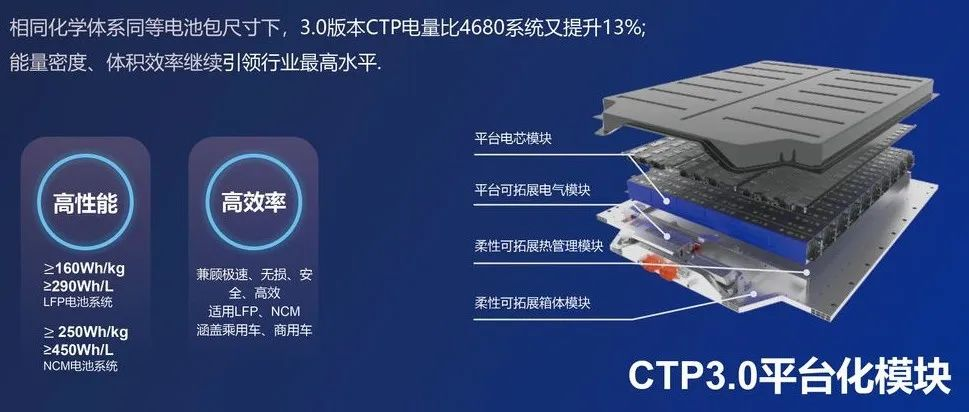Author: Xiao Long and Xiao Jie
According to the official WeChat account of CATL (Contemporary Amperex Technology Co., Ltd.) on May 13th, CATL has signed a strategic memorandum of understanding with Arun Plus Limited (Arun Plus) from Thailand. The two parties will collaborate on battery-related business in the ASEAN region, further enhancing their competitive advantages in the battery industry.

Under the agreement, CATL will authorize ArunPlus to use the CTP (cell to pack) technology, and the two parties will promote the application of CTP technology in Thailand and globally. Arun Plus and CATL will supply battery products to Horizon Plus and other electric vehicle brands. Horizon Plus is a joint venture between Arun Plus and Foxconn and plans to produce electric vehicles in Thailand by 2024.
On May 25th, CATL and Solaris, a European electric bus company, reached a partnership agreement. CATL will provide lithium iron phosphate batteries, which adopt the CTP technology, for Solaris’s bus products to promote electrification of buses in Europe. It is reported that Solaris is one of the public bus and tram manufacturers in Europe, providing urban transportation services to hundreds of cities in Europe.
What is CTP?
CTP technology, also known as Cell To Pack, is a module-less technology where the battery cells are directly integrated into the battery pack. The existing battery pack structure usually consists of a three-level structure of “cell-module-pack”. Several battery cells combined together are called “modules”. Several modules combined together with essential components such as BMS and distribution modules become a “battery pack”.
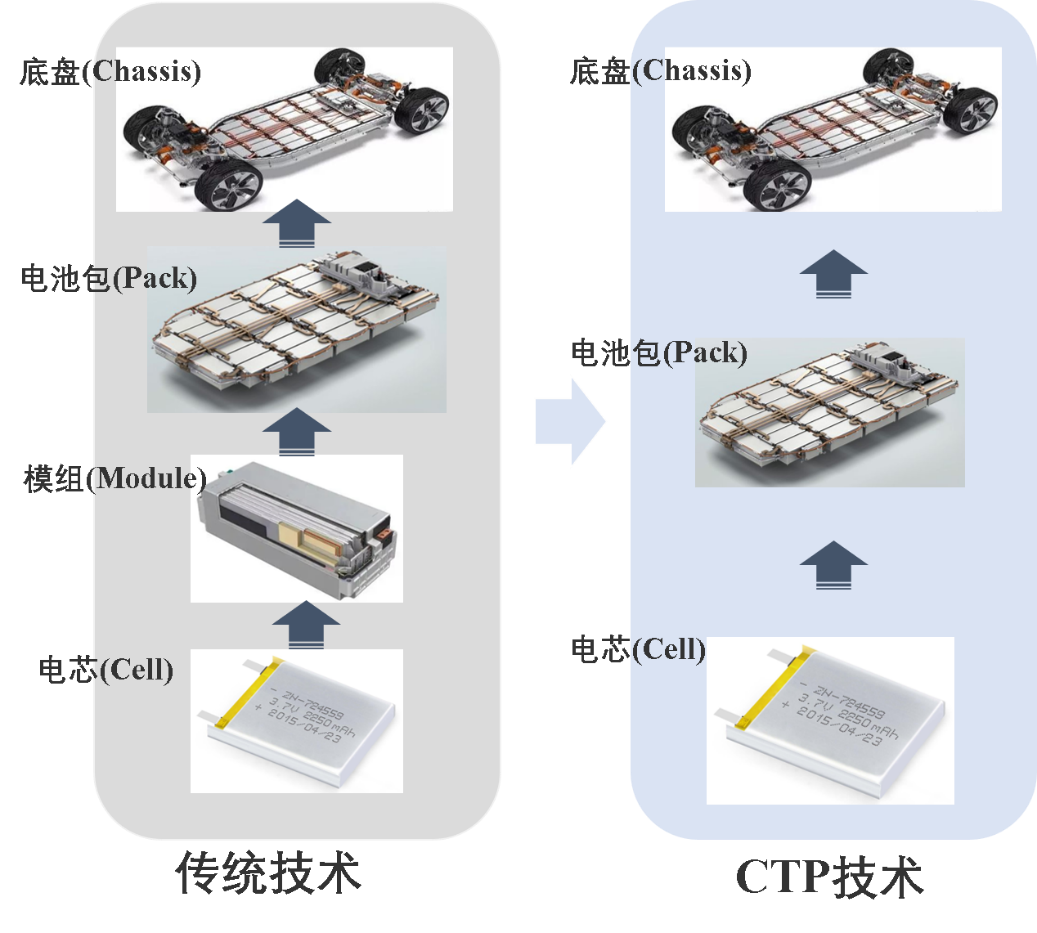
For example, Tesla pre-integrates more than 7,000 battery cells into several modules and finally installs them inside the battery pack. This modular process significantly reduces the complexity of assembly and improves production efficiency. In addition, modular design is beneficial for power battery maintenance, making it easy to replace modules. However, the application of the module increases many other components’ quality and cost of the battery pack.
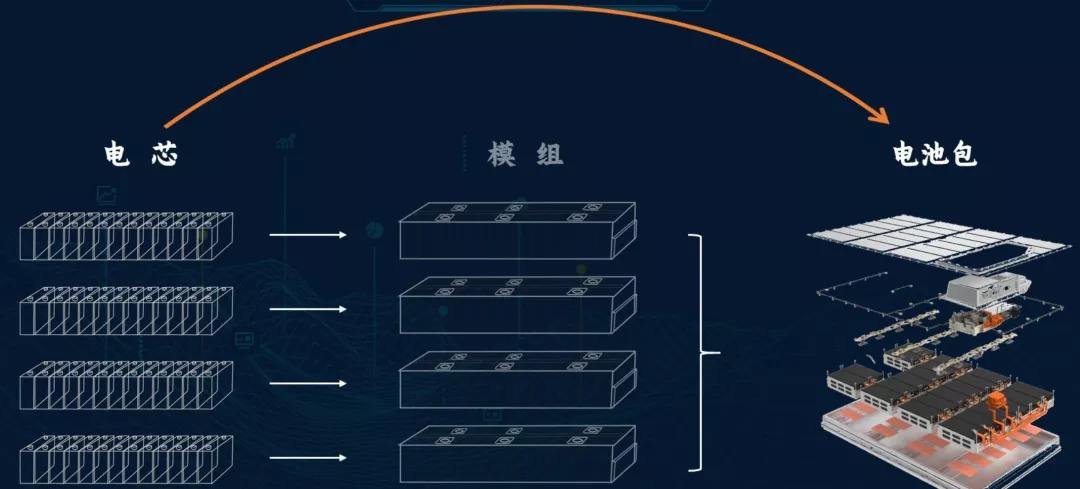
CTP technology currently has two different approaches. One is to completely eliminate modules, represented by BYD’s blade batteries, and the other is to integrate small modules into large modules, represented by CATL batteries.## Contemporary Amperex Technology Launches CTP Battery Pack
In the 2019 Frankfurt International Auto Show, Contemporary Amperex Technology (CATL) launched the latest CTP high-integration power battery development platform and released the world’s first CTP battery pack with Beijing Automotive New Energy.
On March 26th, 2022, Wu Kai, the chief scientist of CATL, confirmed the launch of the Kirin battery pack, the third-generation CTP technology. Its system weight, energy density, and volume energy density are at the top of the industry. The Kirin battery pack can increase the capacity by 13% compared to the 4680 system with a similar size of the battery pack. Wu Kai also hinted that a production system with a 1000 km (621 mile) range with one charge will be available in 2023, and the new CTP technology will become vitally important in the future.
From the concept’s inception to practical implementation, CTP technology has once again become a hot topic of discussion.
As we all know, under the influence of policy subsidies, China’s new energy vehicle market has experienced significant growth in the past few years. However, in 2019, the overall passenger car market was sluggish. Added with the negative impact of the new energy policy subsidy cuts, the growth momentum of the new energy vehicle market has declined. Companies will face enormous pressure in the post-subsidy era; this drives the development of cost-reducing and efficiency-increasing technologies to enhance product competitiveness.
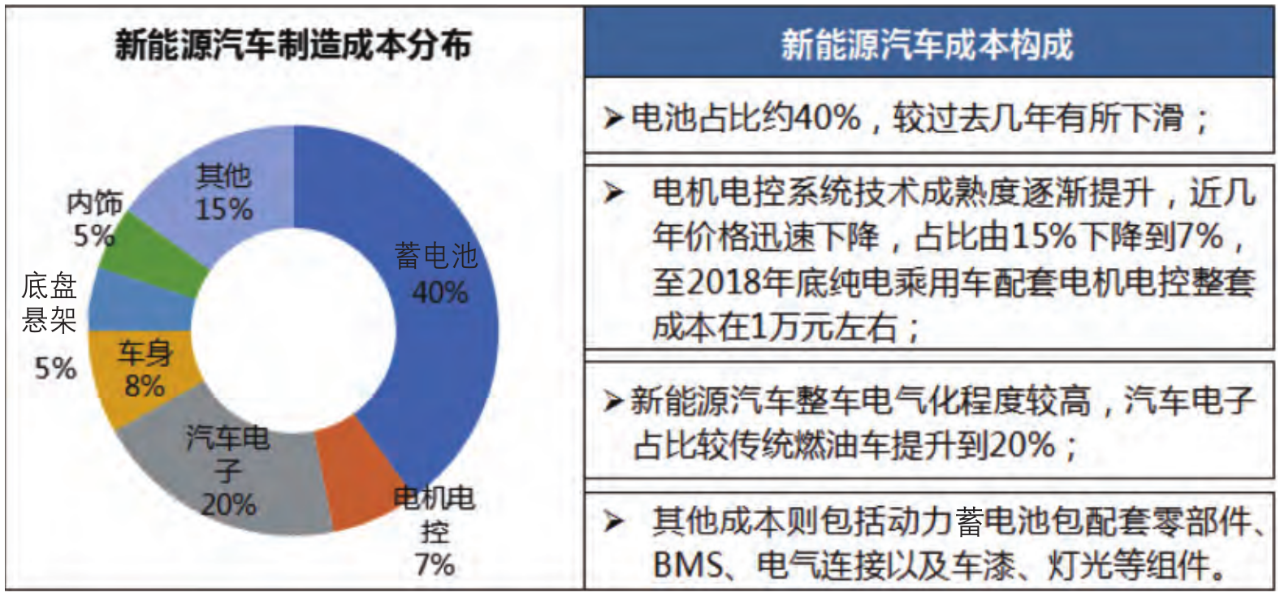
As the industry leader in batteries, the battery cost represents 40% of the entire new energy vehicle. To reduce costs and improve efficiency, CATL proposed the CTP technology. Compared with traditional batteries, the capacity utilization rate of CTP battery packs increased by 15% to 20%, the number of parts reduced by 40%, production efficiency improved by 50%, energy density improved by 10% to 15%, and cost reduced by 10%.
So how does CATL’s CTP technology assist new energy vehicles? What are the differences between CTP battery packs, and what changes will it bring to the new energy vehicle industry? The following analysis will answer these questions.
CATL’s CTP Technology
As shown in the figure, CATL’s CTP battery pack includes two or more battery modules. A large module is divided into small spaces by several plastic heat dissipation sheets that can be inserted into these small spaces like a hard drive.
Removing the battery module and integrating the battery directly into the battery pack can improve the space utilization rate of the battery pack, reduce its quality, increase its energy density, and lower the manufacturing cost of the battery.The battery pack consists of at least two large modules, each module connected to the battery tray with fasteners and finally fixed to different crossbeams. Sleeves are fixed between adjacent frames, which contain channels for fasteners to fix the battery pack to the vehicle, lowers the weight of the battery pack and improves the connection strength of the battery pack in the vehicle.
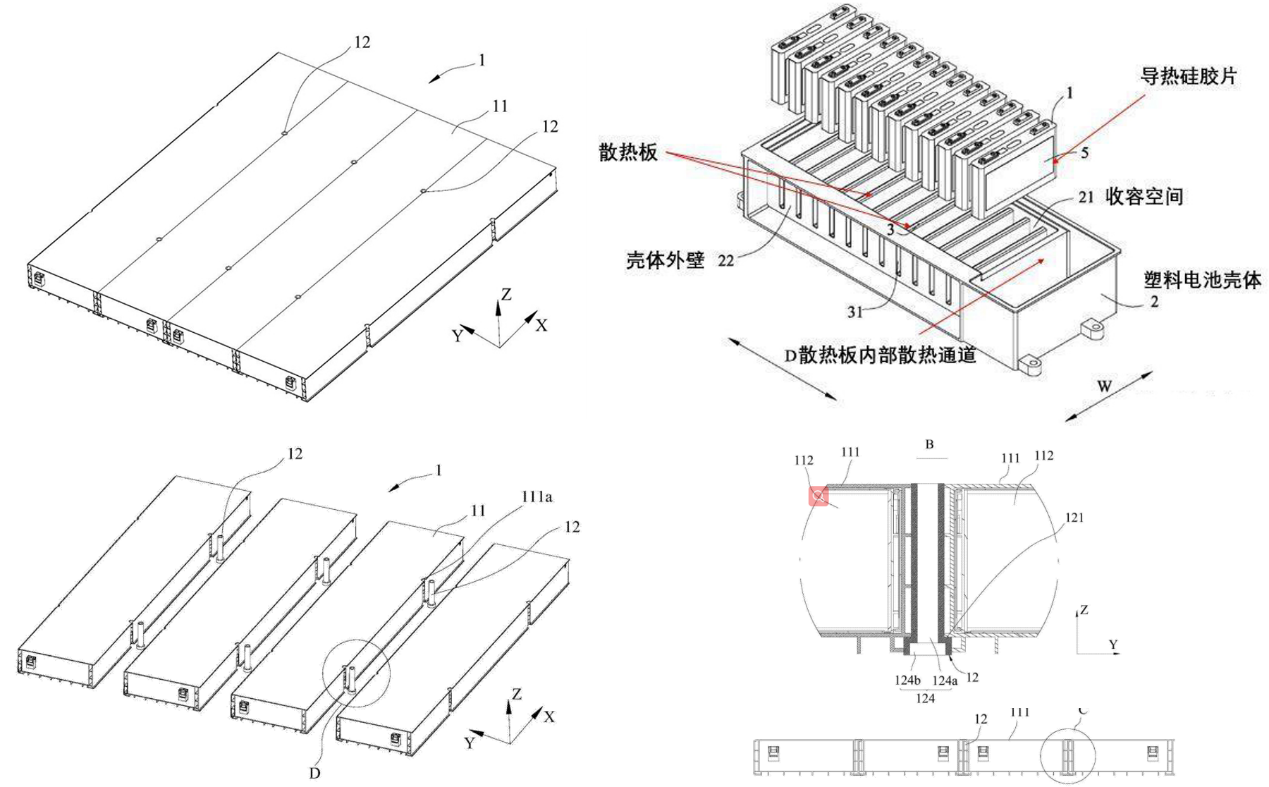
Although CTP technology has many advantages, there are still some problems that need to be constantly improved, such as collision problems caused by structural changes, battery thermal management problems, and after-sales maintenance problems.
How does CATL’s CTP technology solve these problems?
Firstly, it is the battery collision safety issue. The battery cells will directly withstand the impact of the collision except for the edge beams of the battery pack when CTP technology is applied. The frame of the battery pack developed by CATL is extruded directly from aluminum to increase strength.
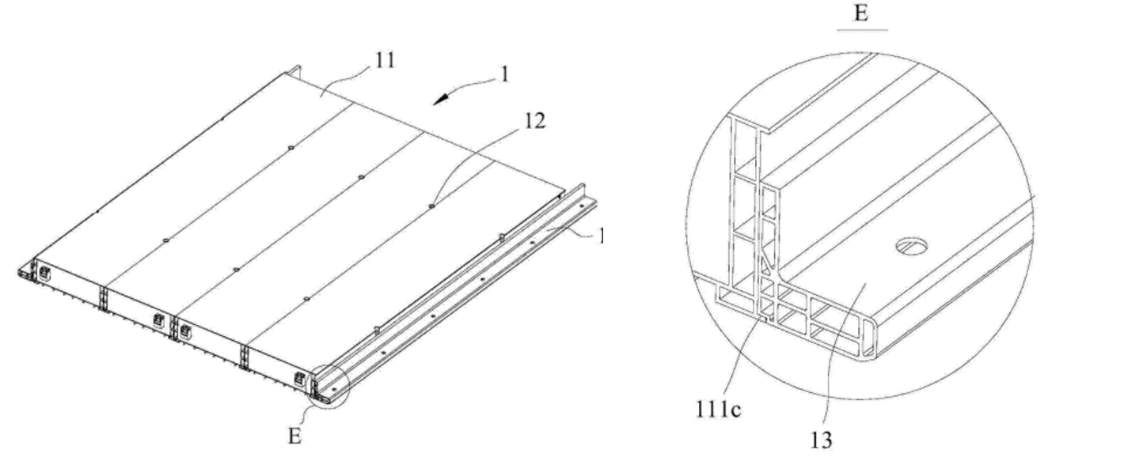
Secondly, the battery’s thermal management is a major factor affecting battery safety. The CTP technology of CATL is applied to every module of the battery pack. Thermal conductive glue is filled into the middle part of the shell, and pressure or temperature sensors are set between the side wall of the battery cell and the shell to detect the shape and temperature changes of the battery, eliminate battery failure and measure the heat dissipating phenomenon earlier.
Finally, the cost of after-sales service has been reduced. In the past, if a battery cell in a small module was damaged, only the module containing that cell had to be replaced. Does the entire battery pack need to be replaced if a battery cell in a CTP battery pack tray fails? This puts higher demands on the consistency of battery cells. The battery pack consists of hundreds of different battery cells, and the output is determined by the worst battery cell. How to monitor and control the charging and discharging status of each battery cell puts forward higher requirements for the battery management system BMS. With years of experience in battery production, CATL can better integrate with CTP technology.
CATL’s 3rd Generation CTP
CATL’s latest CTP 3.0 provides two versions for LFP (lithium iron phosphate) and NCM (lithium nickel cobalt manganese oxide) batteries, which offer competitive energy densities:
LFP:
Weight energy density ≥ 160 Wh/kg
Volume energy density ≥ 290 Wh/L
NCM:
Weight energy density ≥ 250 Wh/kg
Volume energy density ≥ 450 Wh/L# CTP 3.0 System: Improving Energy Density and Thermal Management
The CTP 3.0 system consists of the Platform Lithium-Ion Cell Module, the Extensible Electric Module, the Flexible Extensible Thermal Management Module, and the Flexible Extensible Box Module. The system still uses square-shaped cells, which make better use of the battery’s overall space compared to Tesla’s cylindrical 4680 battery. In theory, the CTP 3.0 square-shaped cells have a higher energy density per unit volume compared to the cylinder-shaped cells of Tesla 4680 battery.
To optimize and reduce the risk of thermal propagation between cells, and to enhance safety, the CTP 3.0 technology released recently has upgraded the electrical and thermal management modules. It has also introduced a modular CTP system that can use 1, 2, or 3 CTP packages according to vehicle type. A single battery unit provides a range of around 200 kilometers, and it adapts to most EV platforms. You can freely combine and choose one, two, or three battery packs according to the actual needs and match different mileage requirements. For the first time, it uses wireless BMS technology. The external parts of the battery only have high-voltage positive and negative interfaces, which greatly increase the reliability of pluggable components.
Insights from the EDS Journal
The journalist from the EDS believes that to increase energy density, power batteries mainly need to make advancements in cathode materials. Although structural optimization is only an auxiliary means, CTP technology is an effective way of cost reduction and efficiency enhancement when there is no significant breakthrough in the energy density of cathode materials.
CTP technology is based on system innovation in high-quality batteries. In the wave of development of new energy vehicles, the development of power battery technology is being pushed to the forefront. Various technological lines are emerging, presenting a “whoever wins the battery wins the world” trend! The upgrade of new energy vehicle powertrain technology is a crucial factor in reducing the cost of new energy vehicles, especially the upgrade of battery technology.
CATL plans to roll out the highly integrated CTC (Cell to Chassis) battery technology by around 2025. Behind CTP and CTC technology, there is an ongoing game between battery companies and automakers. These new technologies have raised the barrier to manufacturing batteries, making it harder for automakers to enter the cell industry, and to only purchase battery packs from battery companies. However, it has also enhanced the bargaining power of battery companies in the supply chain.
With the continuous upgrading of cost-effective technologies such as CTP, CTC technology is expected to quickly be implemented, and the cost will be significantly reduced. It will inevitably usher in the age of price-competitive new energy vehicles.
This article is a translation by ChatGPT of a Chinese report from 42HOW. If you have any questions about it, please email bd@42how.com.
